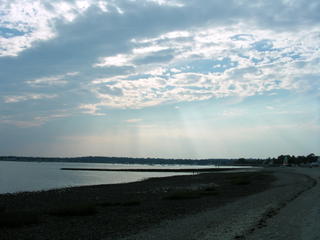Water Quality Continues to Worsen in Western End of the Sound

A few miles further east, at the Western Sound location, between Greenwich and Oyster Bay, DO levels are 2.5 milligrams per liter, or 32 percent of what the water should hold, at 51 feet deep.
Those readings come from UConn's MYSound sensors, and they of course represent just two locations in a big estuary. The area between the two locations no doubt would show a gradient from 0.7 up to 2.5. The Connecticut DEP is sending out its water quality monitoring boat later this week for broader testing, and its results should be available early next week. With hot weather forecast for the next few days, there's probably not much chance that DO levels will do anything but fall.
Near the surface at both the Execution Rocks and Western Sound sensors, DO concentrations are much higher -- 10.1 or 137 percent at the former and 8.2 or 118 percent at the latter. The 137 percent and 118 percent readings mean the water is supersaturated with oxygen, which means there's a bloom of algae occurring.
Here's what the MySound site says about DO saturation:
The amount of dissolved oxygen that water can hold depends on both the water temperature and salinity. Warm water holds far less oxygen than cold water (warm water holds less of any gas then cold water). What this means is -- in the summer, even if the water is 100% saturated, the amount of oxygen availiable for marine organisms may still not be enough. Occasionally, the water can be supersaturated, that is the percent saturation is over 100%. This would happen if there were a phytoplankton bloom (phytoplankton give off oxygen as they photosynthesize) concurrent with 100% saturated water. Saturation is measured relative to what we would expect for a body of still water that has reached equilibrium with the air.
How bad are this year's readings? Let's use 3 milligrams per liter, which is the level at which the water is no longer habitable by fish.
2005 (as of two weeks ago): 60 square miles were below 3 miligrams per liter.
2004: 258 square miles were below 3.5 milligrams per liter.
2003: 345 square miles were below 3.
The low dissolved oxygen conditions typically end in early September, so we have about a month to go of potentially worsening conditions this year.
Looking further back, to the worst of the worst:
1987, the year of the great fish die-offs: 350 square miles were below 3 milligrams per liter.
1989: 517 square miles were below 3.
Dissolved oxygen drops because nitrogen, mainly from treated sewage, fertilizes the Sound's phytoplankton, and when they die and decay, they use of oxygen. The Sound is bad but other coastal waters are much worse. Imagine, for example, if your nitrogen conveyor was as big as the Mississippi River. Actually you don't have to imagine it. The Mississippi River is a nitrogen conveyor, into the Gulf of Mexico, where a vast area -- 4,564 square miles -- is virtually dead again this summer because of low oxygen levels. The area is so big, newspaper accounts need to resort to comparing it in size to states and countries:
The zone's size varies year to year. At 5,800 square miles, last year's was bigger than Connecticut. The record of 8,500 -- about the size of Israel and a bit smaller than New Jersey -- was in 2002.
Nitrogen fertilizes our crops, we consume it when we eat, and it ends up in our sewage, or else it runs off farms into water ways. The Gulf of Mexico, Chesapeake Bay, Long Island Sound -- it's all the same problem.



0 Comments:
Post a Comment
<< Home